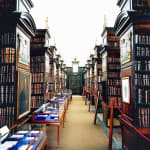
Candida Höfer German, b. 1944
Marsh's Library Dublin I 2004
C-print
177 x 152 cm; (69 5/8 x 59 7/8 in.)
Edition of 6 (#4/6)
Copyright The Artist
Further images
Candida Höfer’s Marsh’s Library Dublin I 2004 forms part of a broader series documenting Dublin’s most historically significant libraries and institutional interiors. Taken during her visit to the city in...
Candida Höfer’s Marsh’s Library Dublin I 2004 forms part of a broader series documenting Dublin’s most historically significant libraries and institutional interiors. Taken during her visit to the city in 2004, the series includes images of the National Library of Ireland, the Long Room of Trinity College’s Old Library, and the Great Hall and Chapel of the Royal Hospital Kilmainham. Within this body of work, her photograph of Marsh’s Library stands out as a meditation on time, preservation, and the quiet endurance of scholarship.
Founded in 1707, Marsh’s Library was Ireland’s first public library and remains one of the most well-preserved early Enlightenment libraries in Europe. Commissioned by Archbishop Narcissus Marsh and designed by Sir William Robinson – Surveyor General of Ireland and architect of the Royal Hospital Kilmainham – the library’s interior remains largely unchanged since its inception. Dark oak bookcases, original furnishings, and distinctive wire-fronted reading cages evoke the scholarly ideals of the late Renaissance, offering a rare glimpse into the intellectual atmosphere of the early 18th century. The collection, comprising over 25,000 volumes and 300 manuscripts, reflects the breadth of early modern scholarship, with particular strengths in classical literature, science, and theology. Remarkably, many books remain in their original 18th-century arrangement, reinforcing the library’s historical continuity.
Höfer’s photograph captures this enduring atmosphere with her characteristic precision. Renowned for her rigorous approach to documenting cultural institutions, she employs a careful interplay of natural light and architectural symmetry to reveal the library’s measured grandeur. Her framing accentuates the depth of the space, guiding the eye along the rows of aged volumes and towards the vanishing point of history itself. The absence of human presence – a hallmark of Höfer’s work – heightens the meditative quality of the image, inviting reflection on the ways in which knowledge is preserved and displayed.
Through her lens, Marsh’s Library is not merely an archive of books but a monument to intellectual tradition. Höfer’s work transforms this historic space into a visual meditation on time and memory, highlighting the fragile yet enduring relationship between past and present, between knowledge and the spaces that safeguard it.
Founded in 1707, Marsh’s Library was Ireland’s first public library and remains one of the most well-preserved early Enlightenment libraries in Europe. Commissioned by Archbishop Narcissus Marsh and designed by Sir William Robinson – Surveyor General of Ireland and architect of the Royal Hospital Kilmainham – the library’s interior remains largely unchanged since its inception. Dark oak bookcases, original furnishings, and distinctive wire-fronted reading cages evoke the scholarly ideals of the late Renaissance, offering a rare glimpse into the intellectual atmosphere of the early 18th century. The collection, comprising over 25,000 volumes and 300 manuscripts, reflects the breadth of early modern scholarship, with particular strengths in classical literature, science, and theology. Remarkably, many books remain in their original 18th-century arrangement, reinforcing the library’s historical continuity.
Höfer’s photograph captures this enduring atmosphere with her characteristic precision. Renowned for her rigorous approach to documenting cultural institutions, she employs a careful interplay of natural light and architectural symmetry to reveal the library’s measured grandeur. Her framing accentuates the depth of the space, guiding the eye along the rows of aged volumes and towards the vanishing point of history itself. The absence of human presence – a hallmark of Höfer’s work – heightens the meditative quality of the image, inviting reflection on the ways in which knowledge is preserved and displayed.
Through her lens, Marsh’s Library is not merely an archive of books but a monument to intellectual tradition. Höfer’s work transforms this historic space into a visual meditation on time and memory, highlighting the fragile yet enduring relationship between past and present, between knowledge and the spaces that safeguard it.
